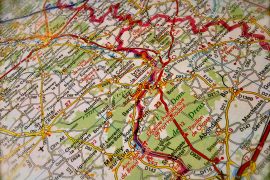Earlier this month, I showed you how to convert currencies, when given the exchange rate. When you’re not using an online calculator, that process involves proportions, which are pretty simple to use, but do require a little figuring on paper. This same process works for any conversions, including miles to kilometers, liters to ounces, etc.
But while being exact with your money is pretty important, estimating how far you have to drive or walk is usually good enough. So instead of going into details about metric-to-traditional measurement conversions, let’s look at how you can find these distances with a little mental math. First, you’ll need to know a few facts:
1. A mile is longer than a kilometer. So, when you convert miles to kilometers, the answer will be larger than the original amount. (mi –> km = larger answer)
2. A kilometer is shorter than a mile. So, when you convert kilometers to miles, the answer will be smaller than the original amount (km –> mi = smaller answer)
2. In fact, 1 mile equals 1.61 kilometers. And 1 kilometer equals 0.625 mile.
3. Those values are pretty darned close to 1.5 kilometers and 0.5 mile.
Remember, we’re estimating here, so you’re not looking for an exact answer. Forget what your middle school math teacher said about the precision of math. You don’t always need to getan exact answer. But there’s another fact you’ll need to consider:
4. The larger the value that you’re converting, the less precise your answer will be.
If you depend on the estimate 1 mi = 1.5 km and you’re converting 15 mi to km, your answer will be pretty close. BUT if you’re converting 1,468 mi to km, your estimate will be a lot lower than the actual answer.
Look, estimating is no big deal. In fact it’s a really, really powerful tool that can make your life much easier. You do need to know when estimation is in your best interests and when you should pull out the calculator. (See? Math really isn’t all that black and white!)
Let’s look at an example. Zoe has finally made it to London! She’s spending the summer studying Shakespeare and working part-time as a docent at the Tate Modern. And she’ll have some time to roam around Europe a bit. She’s rented a car so that she can chart her own path, and next Friday afternoon, she’s going to cross the channel to France, where she hopes to spend four days winding her way down to Paris and back.
But how long will it take her to get there? According to her map, the distance is 454 km. Since Zoe is used to miles, she’d like to convert the distance so that it makes more sense to her. She’s okay with a rough estimate, especially since she has no firm schedule. So she decides that knowing there are about 1.5 km in a mile is good enough.
To make the math even easier, she decides to round the distance as well: 450 is pretty close to 454. Now she can easily do the math in her head, but we’ll get to that in a minute. Let’s write it out first.
Because she’s converting kilometers (shorter) to miles (longer), her answer will be smaller than the original amount. That means she’ll need to divide.
450 km ÷ 1.5 = 300 mi
So she’ll travel about 300 miles to get from London to Paris — not a huge distance!
But how could she do this in her head? For that, she’ll need to remember a few things about fractions.
1.5 = 3/2
450 ÷ 1.5 = 450 ÷ 3/2
450 ÷ 3/2 = 450 • 2/3
(That’s because when you divide by a fraction, it’s the same thing as multiplying by its reciprocal — or the same fraction upside down.)
So in order to convert kilometers to miles in her head, she’ll need to multiply the value by 2 and then divide by 3 (which is the same as multiplying the value by 2/3. In other words:
450 • 2/3 = (450 • 2) ÷ 3 = 900 ÷ 3 = 300
Whew!
But once Zoe remembers this little trick, she can estimate these conversions quickly and easily.
30 km = ? mi
30 km • 2 = 60
60 ÷ 3 = 20
30 km = 20 mi (approximately)
Make sense? Try it for yourself: convert 75 km to mi and then use an online calculator to check your answer. Remember, if you’re using the process above, you’ll get an estimate, not an exact value!
So take a guess: If you’re converting mi to km, what process would you use? See if you can figure it out and then offer your explanation in the comments section. Feel free to choose a value to convert, if it’s easier to explain that way.
